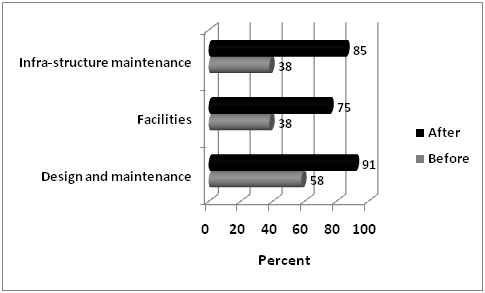MOJ
eISSN: 2381-182X


Short Communication Volume 3 Issue 2
Department of Food Science and Nutrition, University of Mysore, India
Correspondence: Jamuna Prakash, Department of Food Science and Nutrition, University of Mysore, Mysuru, India
Received: June 17, 2016 | Published: November 10, 2016
Citation: Mishra M, Prakash J. Impact of awareness creation program on food safety management system in institutional catering. MOJ Food Process Technol. 2016;3(2):278-279. DOI: 10.15406/mojfpt.2016.03.00068
How do we emphasize the importance of food safety in food handling where the ingredients may be from a standard source but the people and kitchen may not be appropriate or trained for safe food handling? Commercial catering is one of the most flourishing food business globally and in India, it is largely an unorganized sector. There are hotels, restaurants, food stalls, street vendors and institutional catering in schools, colleges, factories, offices, hospitals, marriage halls, and other spaces where large part of population works and/or congregates. The food is either cooked inside the set up or is transported from an external kitchen. The commercial catering is for urban working class consumers who depend on food cooked at these kitchens. The changing work and lifestyle patterns of this demographic, eating out population has almost become a necessity leading to a cultural revolution in eating patterns. Most urban workers consume at least 1 meal per day out of home. Under such circumstances, it is of utmost importance that commercial food establishments serve safe and hygienic food to the consumers.
When we are assessing the risk factors of eating out vs eating at home, home cooked food is safe to a certain extent as it is handled by one or two people. On the contrary, food handling in commercial catering set-ups is a highly complex, technical and an administrative process requiring the services of multiple handlers. To identify the challenges in the process of food handling in these commercial kitchen, a study was conducted to understand the requirements to run a safe kitchen in the city of Bengaluru, South India. Specifically, the aim of the study was to understand whether the food service providers were taking any steps to ensure that food does not cause any adverse health effects on the consumers. A food court within the premises of a large corporate institution was selected as the sample for the study.
The study started with the assessment of risk involved in operations followed by suggesting solutions for each problem to the management and support in closure of the risks. The system adopted for the purpose was Food Safety Management System involving hazard analysis and critical control point (HACCAP) principles. Food Safety Management System (FSMS) is a network of interrelated elements that includes programs, plans, policies, procedures, practices, processes, goals, objectives, methods, controls, roles, responsibilities, relationships, documents, records, and resources to ensure that safe food is served to consumers without affecting their health.
As part of the plan to roll out FSMS in 10 commercial kitchens at the food court, data on various parameters including the kitchen and service area design and infrastructure were collected. Please note that the design and infrastructure of a kitchen are prerequisites for FSMS and critical for operations. The initial gaps identified in design and infrastructure were as follows –
The design risks identified during gap audit posed a major challenge towards achieving FSMS. The overall risk associated with running live food operations were evaluated and 3 out of the 10 kitchens were considered to be in the high risk zone. As a result of this study, the operations at these three outlets had to be closed immediately. As part of the gaps identified in Critical Control Point (CCP) areas, a total of 32 points were specific to design, facility and infrastructure maintenance. These gaps covered specific aspects like flow of operations, the separation of rest rooms, sewage and drain system, absence of manholes, garbage handling including dump yard, floors, doors, ceiling, exhaust, vent, lighting, water facility and structures to support operations. The percent compliance as a result of awareness creation program in study area kitchens before and after is presented in Figure 1.

Figure 1 Impact of awareness creation on compliance level of food safety management in catering establishments.
The facility management of the food court was walked through the gaps identified and they were educated about the drawbacks of the existing mechanism and challenges in achieving FSMS. The awareness drive led to realization that kitchen design is one of the most important aspects in food safety. The management drew up an action plan to prioritize issues and correct design flaws. With the support of Food Business Owners (FBOs), food court staff, facility supervisors and food safety experts, the necessary changes were brought into effect over a period of 12 months. This lead to closure of 24 gaps points in the specified areas. This risk mitigation strategy was highly effective in ensuring safe and hygienic food is cooked and served to thousands of consumers through the day from these kitchens.
Unfortunately, kitchen design is not afforded the kind of importance that it deserves during the planning phase. This leads to safety and hygiene issues when operations are kicked off and poses major challenges to day to day operations and expansion plans. Along with the many other challenges in commercial catering that needs to be addressed, the need for appropriate kitchen design is critical for better utilization of infrastructure and resources to produce safe food. Standardization of design based on the operational needs of commercial kitchens serving Indian cuisine is the need of the hour.1-3
None.
The author declares no conflict of interest.

©2016 Mishra, et al. This is an open access article distributed under the terms of the, which permits unrestricted use, distribution, and build upon your work non-commercially.